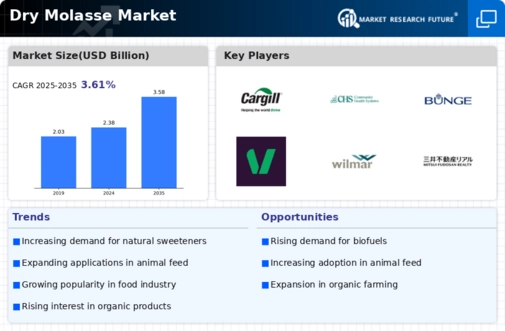Market Growth Projections
The Global Dry Molasse Market Industry is poised for substantial growth, with projections indicating a market value of 2.38 USD Billion in 2024 and an anticipated increase to 3.58 USD Billion by 2035. This growth trajectory is supported by a compound annual growth rate of 3.77% from 2025 to 2035. Such figures suggest a robust demand for dry molasses across various applications, driven by trends in health consciousness, sustainability, and the expansion of organic products. The market's evolution reflects the increasing recognition of dry molasses as a valuable ingredient in multiple sectors.
Growth in the Organic Food Sector
The Global Dry Molasse Market Industry is positively impacted by the growth in the organic food sector. As consumers increasingly prefer organic products, the demand for organic dry molasses is on the rise. This trend is driven by the perception of organic foods as healthier and more environmentally friendly. Manufacturers are responding by sourcing organic dry molasses to meet consumer preferences, thereby expanding their product offerings. The market's growth is anticipated to be sustained, with a compound annual growth rate of 3.77% projected for the period from 2025 to 2035, reflecting the increasing integration of dry molasses in organic food formulations.
Rising Demand for Natural Sweeteners
The Global Dry Molasse Market Industry experiences a notable increase in demand for natural sweeteners as consumers become more health-conscious. This shift towards healthier alternatives is driven by a growing awareness of the adverse effects of artificial sweeteners. Dry molasses, being a natural byproduct of sugar production, offers a rich source of nutrients and flavor, appealing to both consumers and manufacturers. As a result, the market is projected to reach 2.38 USD Billion in 2024, reflecting a robust growth trajectory. This trend indicates a potential for further expansion as more food and beverage companies incorporate dry molasses into their products.
Expansion of Animal Feed Applications
The Global Dry Molasse Market Industry is significantly influenced by the expansion of its applications in animal feed. Dry molasses serves as an excellent energy source and palatability enhancer for livestock, which is increasingly recognized by farmers and feed manufacturers. The growing livestock sector, particularly in developing regions, drives the demand for nutritious feed additives. This trend is expected to contribute to the market's growth, with projections indicating a rise to 3.58 USD Billion by 2035. The increasing focus on improving livestock health and productivity further solidifies dry molasses's role in animal nutrition.
Technological Advancements in Processing
The Global Dry Molasse Market Industry is experiencing a transformation due to technological advancements in processing methods. Innovations in extraction and drying techniques enhance the quality and efficiency of dry molasses production. These advancements not only improve the nutritional profile of the product but also reduce production costs, making dry molasses more accessible to manufacturers. As technology continues to evolve, it is likely to drive market growth by enabling the production of higher-quality dry molasses that meets the diverse needs of various industries, including food, beverage, and animal feed.
Sustainability and Waste Reduction Initiatives
The Global Dry Molasse Market Industry benefits from sustainability and waste reduction initiatives within the food processing sector. As industries strive to minimize waste, the utilization of byproducts like dry molasses becomes increasingly relevant. This not only enhances resource efficiency but also aligns with global sustainability goals. Companies are adopting practices that incorporate dry molasses into various applications, including food, beverages, and animal feed. Such initiatives are likely to bolster market growth, as organizations seek to improve their environmental footprint while capitalizing on the nutritional benefits of dry molasses.





















Leave a Comment